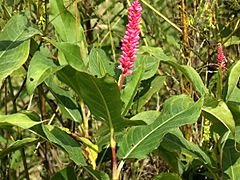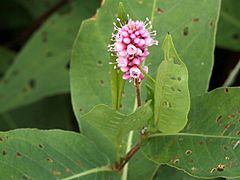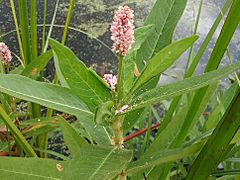Persicaria amphibia facts for kids
Quick facts for kids Persicaria amphibia |
|
|---|---|
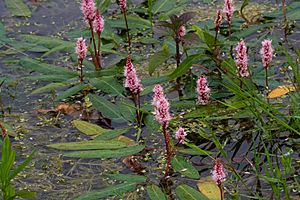 |
|
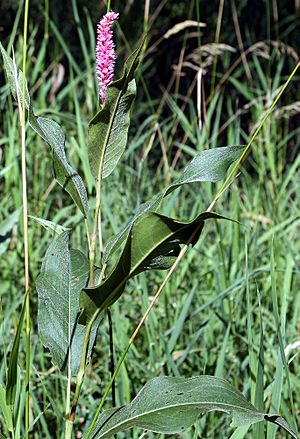 |
|
| Conservation status | |
| Scientific classification | |
| Genus: |
Persicaria
|
| Species: |
amphibia
|
| Synonyms | |
|
Synonymy
Polygonum amphibium L.
Chulusium amphibium (L.) Raf. Chulusium fluitans Raf. Chulusium natans Raf. Persicaria amurensis (Korsh.) Nieuwl. Persicaria coccinea (Muhl. ex Willd.) Greene Persicaria fluitans Montandon Persicaria hartwrightii (A. Gray) Greene Persicaria muhlenbergii (Meisn.) Small Polygonum amphibium L. Polygonum coccineum Muhl. ex Willd. Polygonum emersum (Michx.) Britton Polygonum hartwrightii A. Gray Polygonum muhlenbergii (Meisn.) S. Watson Polygonum natans Eaton Polygonum rigidulum E. Sheld. Polygonum salicifolium Schur 1866 not Brouss. ex Willd. 1809 |
|
Persicaria amphibia is a cool flowering plant. It is also known as longroot smartweed, water knotweed, water smartweed, or amphibious bistort. This plant is part of the knotweed family. You can find it naturally in many parts of North America, Asia, Europe, and some areas of Africa. It has also been brought to other places. Sometimes, it can even grow as a problem plant.
Contents
Where Persicaria amphibia Grows
This plant grows across a huge area in the northern half of the world. This includes places like Europe, Asia, North America, and parts of Africa. It has also been introduced to other regions, such as South America.
Plant Habitats
Persicaria amphibia likes to grow in many kinds of wet places. You can find it in ponds, streams, and marshes. It is a perennial herb that grows from underground stems called rhizomes. This means it comes back year after year.
The plant can look very different depending on where it grows. It might be an aquatic plant, living completely underwater or floating on top. It can also grow in muddy, wet areas that sometimes get covered by water. Sometimes, it even grows in moist spots on land, like in meadows.
Plants that grow on dry land and those that live fully in water are sometimes seen as different types of the same species.
What Persicaria amphibia Looks Like
Persicaria amphibia grows a thick stem from its underground rhizome. This stem can creep along the ground, float on water, or stand upright. It can also grow roots from its stem parts that touch wet soil.
Stem and Leaves
Stems of plants growing in water can reach up to 3 meters (10 feet) long. The stems have ribs and can be smooth or quite hairy.
The leaves are usually shaped like a spear, but they can have other shapes too. They grow on stalks called petioles. Some leaves can be over 30 centimeters (1 foot) long.
Flowers and Fruit
The plant's flowers grow in a thick cluster at the end of the stem. These clusters have many pink flowers, each with five small parts.
Some plants have flowers with both male and female parts. Other plants might have only male or only female flowers. The fruit is a small, shiny brown, round achene. It is about 3 millimeters long.
Different Types of Persicaria amphibia
Scientists generally recognize three main types, or varieties, of this plant. However, some experts think one type, P. a. var. emersa, is actually its own separate species called Persicaria coccinea.
- P. a. var. emersa (longroot smartweed) – This type usually grows on land or in muddy areas. Its stems often stick out of the water. Its leaves have pointed tips and grow on stalks. The flower spikes at the end of the stem are usually two, uneven in size, and longer than 4 cm.
- P. a. var. stipulacea – This type usually floats in water. Its stems and leaves float on the surface. When it gets stuck on land, its leaf bases might look flared. Any leaves that grow in the air are almost directly attached to the stem and have blunt tips. The flower spikes are usually one and longer than 4 cm. In North America, this type does not grow south of the Laurentide Ice Sheet, except in the western mountains and Mexico.
- P. a. var. amphibia – This type is mostly found in Europe.
Uses of the Plant
Different parts of Persicaria amphibia were used by several Native American groups. They used it as medicine for various health issues. Sometimes, they also used parts of the plant as food.
See also
 In Spanish: Polygonum amphibium para niños
In Spanish: Polygonum amphibium para niños



